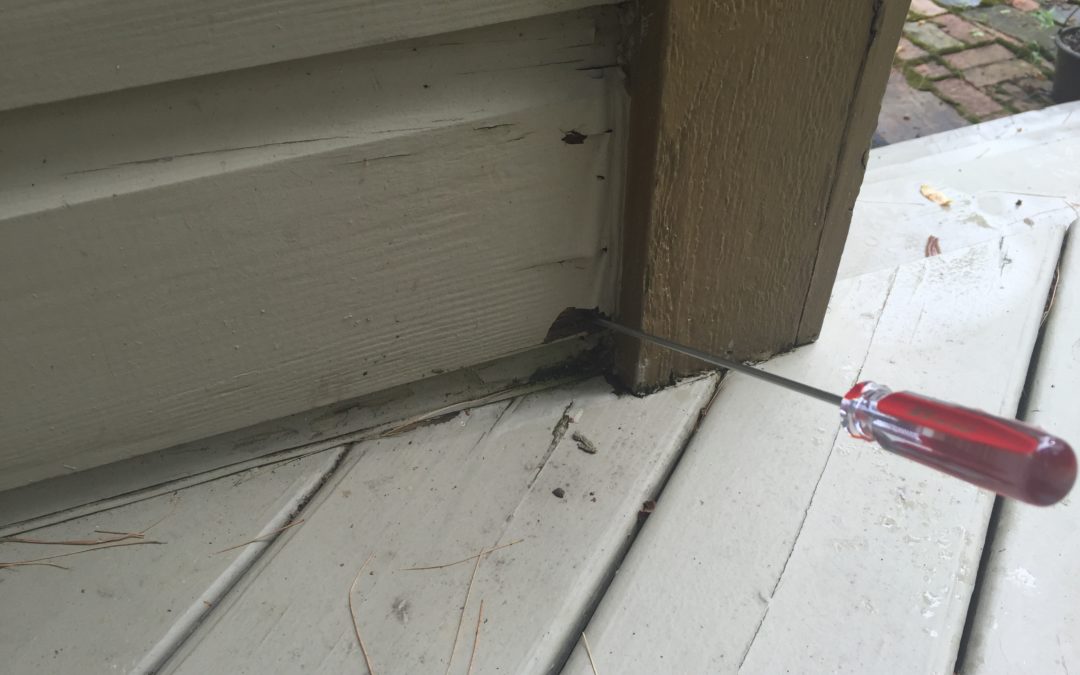Wood decay, also known as wood rot, is the decomposition of wood as the result of actions by certain species of fungi.
Facts about wood decay:
Carpenter ants, termites and other wood-destroying insects do not cause wood decay. These insects are, however, attracted to wood that has been softened by decay. Decay fungi are active in temperatures between 77° F to 90° F, and need water, oxygen and a food source to survive. Fungi that cause wood decay are called saprophytic, a term also applied to other organisms that consume decayed material. Many species of fungi, along with saprophytic beetles, worms, protists and bacteria are essential components of the decomposition and nutrient cycles.
How does wood decay happen?
Fungi reproduce by manufacturing single-celled spores, similar to microscopic seeds. Spores are tough; they’re able to resist extreme conditions of White decay temperature and humidity and, under adverse conditions, they may go dormant for long periods. Spread primarily by air currents, they collect on horizontal surfaces. Decay fungi feed on the cellulose and lignin of which wood cell walls are composed. Their hyphae, which are threadlike tubes that penetrate the wood, secrete enzymes which dissolve at least part of the wood cell being fed upon, changing it into a form which can then be absorbed as food. Spores require a moisture content higher than the Fiber Saturation Point (FSP) of the wood species upon which they rest, typically between 27% and 30%. Once sufficient water and favorable temperatures are available, spores germinate and develop by extending a hyphal tube. As more spores germinate, fungi multiply to form a colony. Under the right conditions, colonies can expand quickly.
Common types of wood decay:
Brown rot: This type of decay causes the wood to break down into brown cubes that split against the grain. Advanced stages of brown decay result in dry, powdery wood that is unable to support much weight, and crumbles easily.
White rot: This type of decay appears whitish, stringy and mushy, and tends to be more common in hardwoods.
Dry rot: A misnomer, this term has been used to describe decayed wood that has since dried and ceased decaying. Some people may erroneously assume that the wood is still in the process of decay. Moisture is required for wood decay to occur, so no literal “dry rot” exists.
Peter Young Home Inspections check any areas suspected of containing decay by probing. A screwdriver works well for this. Wood with advanced decay will be soft and the probe will penetrate easily. Areas with incipient decay may be a little trickier to identify. The pick test can also be used to identify decayed wood. To perform this test, a pointed tool, such as an ice pick, is inserted beneath the wood grain to pry loose a thin section of wood till it breaks free. Sound wood will snap crisply and typically breaks off to one side of the pick. Decayed wood will break with a dull sound and usually breaks above the pick’s point of insertion.
Although wood-destroying insects, such as termites, are attracted to decayed wood, they also inhabit sound wood. Peter Young Home Inspections offers Wood Destroying Insect Inspections as an add-on service.
Decay Prevention
If the decay hazard is high, select the heartwood of decay-resistant species, or use wood properly treated with a good preservative.
• Proper grading can prevent water from seeping under the house.
• Effective roof overhangs, gutters and downspouts should be installed.
• No untreated wood should be placed within 18 inches of the ground.
• Adequate cross-ventilation in crawlspaces will help eliminate dead air pockets, which contribute to wood decay.
• A vapor barrier can be installed on the soil surface to help limit evaporation and return moisture to the soil, rather than allowing it to condense on the floor and above joists. Plastic sheets can cover the soil to act as satisfactory barriers.
• Dehumidifiers and bathroom and kitchen fans will reduce indoor water vapor, and potentially dry wood enough to prevent decay.
Likely decay locations
• Stairs and attachment points to the house in decks
• Improperly installed door thresholds, especially beneath sliding glass doors
• Decks at or near grade
• Ground-roof penetration
• Roof penetrations with improper or corroded flashing
• Beneath windows
• Support post bases of decks
• Near corrosion of fittings on plumbing
• Basements or crawlspaces where hosebibs may have burst
• Sub-floors at the base of toilets and tub corners
• Uphill side of chimneys
• Sidewall and headwall locations
• Untreated wood in direct contact with concrete, masonry or soil
Moisture can come from:
• General moisture intrusion of building envelope
• Plumbing leaks
• Snowmelt
• Improperly installed, damaged or corroded flashing
• Ice dams
• Finish grades that slope toward the foundation
• Foundation cracks
Types of naturally resistant and non-resistant wood
Resistant woods: teak, rosewood, oak, redwood, cedar, black locust, red mulberry and yews.
Non-resistant woods: hemlock, pine, maple, aspen, alder, elm, birch, buckeye, poplar and beech.
In summary, wood decay is caused by fungi that are attracted to wet locations. For a home inspection contact Peter Young at 828-808-4980.
